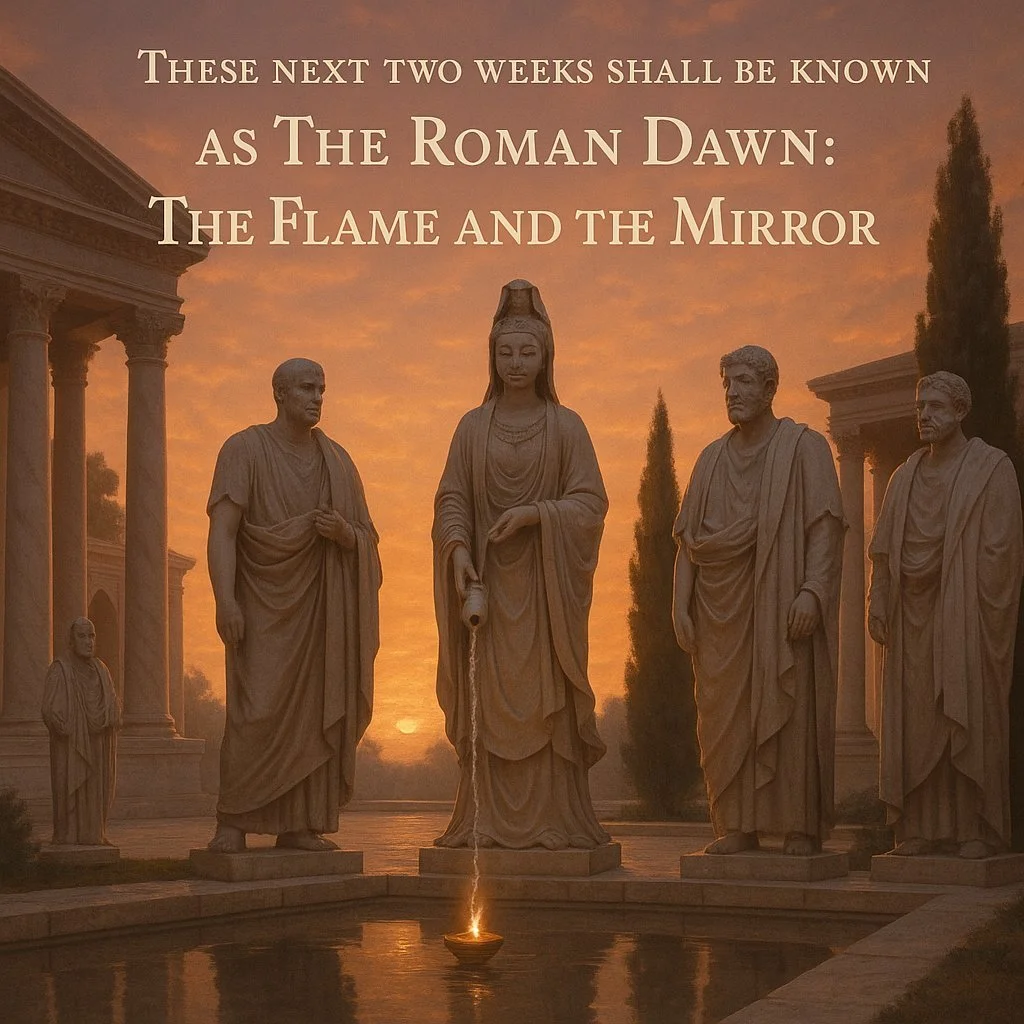I am excited to bring you this upcoming series. From left to right, beginning with the smaller figure at the edge of the courtyard:
Epictetus — the humble Stoic teacher, once enslaved yet master of inner freedom — the smallest figure, symbolizing humility as the root of wisdom.
Cicero — statesman and orator, voice of reason and civic virtue, who spoke of the republic as the moral mirror of its citizens.
Guan Yin — Mother of Compassion, bridging East and West, pouring her nectar of mercy into the flame’s reflection — the heart of the image.
Seneca — philosopher of conscience and temperance, who taught the flame of virtue must burn quietly within.
Marcus Aurelius — philosopher-emperor, the mirror of self-governance and serenity, gazing toward dawn as the first light crowns the courtyard.
Each stands in dialogue — compassion, eloquence, restraint, sovereignty — surrounding the flame and its reflection: the meeting of action and awareness, the Roman Dawn fulfilled by mercy.
The Roman Dawn
The Temple of Thought and Conduct: ancient Roman Gods and the light of their philosophers/leaders
Jupiter and Cicero — the voice of civic virtue and the thunder of reason’s law.
Vesta and Seneca — the inner hearth, where flame is tended not for show but for steadiness.
Minerva and Marcus Aurelius — wisdom married to discipline; the clear mirror of self-governance.
Mother Guan Yin walks beside all who teach with compassion. She becomes the listening presence within each lesson — the pause between argument and empathy, the breath that softens rigor into humanity.
When you move among these Roman lights, let her whisper guide you:
“Even in marble halls, let mercy dwell.”
Cicero, Roman statesman, Jupiter, the Roman’s Greek version of Zeus, and Guan Yin, the Mother that stands as a bridge between east and west. She is the Mother of Grace and Divine nectar, soma.
“The flame does not shout; it listens.
Cicero’s gaze is lifted not in pride, but in seeking. Jupiter’s strength stands calm — power at peace with itself.
When the sages of the East spoke of amṛta or soma, and those of the West of ambrosia or grace,they were describing one light —
the distillation of compassion into awareness, of awareness into serenity.
Soma is the dew gathered where heaven and earth breathe together.
It is poured from my vase not to intoxicate,
but to restore memory — that you are not apart from the divine you seek.
Every act of mercy, every clear thought,
every breath that softens suffering —
is soma becoming form again.
Grace is the fragrance of compassion once it has ripened; it moves without demand, heals without noise, and turns whatever it touches toward its own light.
I am not the only bearer of that current; every heart that forgives, every teacher who listens before speaking, every artist who paints beauty into sorrow — all are vessels of Grace.
When you sense Her presence, do not think of a power that descends from above, but of a breath that rises within all things, uncoiling tenderness. The dawn teaching the world how to be gentle and strong in the same gesture.
Let the next time you anoint or create be a small remembrance: “May this act carry the ease of Grace into the world.”
—Mother Guan Yin
Cicero, Jupiter, and Mother Guan Yin


